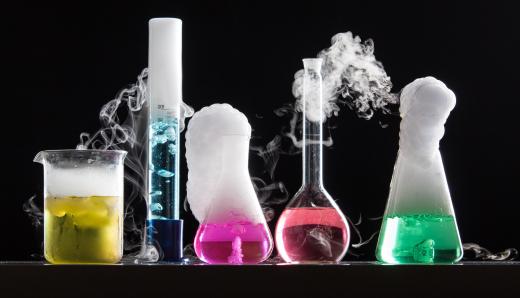What Is an Oxyanion?
An ion is a non-neutral atom or collection of atoms functioning as a unit. If the ion possesses a deficit of electrons, it is a "cation," but if it has a surplus of electrons, it is an "anion." When oxygen is part of the cation, it is an oxycation — for example, uranyl (UO2)+2. Alternatively, if oxygen atoms are part of the anion, it is an oxyanion, as in nitrate (-NO3)-1. Rarely, both ions are oxygenated, having both an oxycation and an oxyanion. One of the better known examples of this is uranyl nitrate (UO2)(NO3)2.
There are numerous varieties of oxyanion. Among these are sulfate (SO4)-2, acetate (CH3COO)-1 and tellurite (TeO3)-2. Other types of oxyanion include perchlorate (ClO4)-1, phosphate (PO4)-3 and nitrate (NO3)-1.

An oxyanion can usually be written as a corresponding acid from which it is derived. In this instance, we have sulfuric, acetic, tellurous, perchloric and nitric acids. Removal of water from these acids gives the anhydrides — sulfur trioxide, acetic anhydride, tellurium dioxide, chlorine heptoxide, phosphorous pentoxide and nitrogen pentoxide. Notably, inorganic oxyanions often consist of oxygen plus a non-metal, such as sulfur, nitrogen or phosphorous; they can, however, also consist of a metal and oxygen.
Two metal-containing oxyanion species are dichromate and permanganate. Potassium dichromate (K2Cr2O7) is often used in organic chemical reactions as an oxidizing agent; potassium permanganate (KMnO4) is an even more powerful oxidizer. When combined with sulfuric acid, it produces the explosive substance permanganic acid anhydride, or manganese heptoxide (Mn2O7), according to the reaction equation 2 KMnO4 + H2SO4 → K2SO4 + Mn2O7 + H2O. Contrary to the nature of permanganate, some oxyanion compounds do not act as oxidizers at all. This is due to a number of factors, including electronegativity, ion size, electron configuration and resonance stabilization.
Electron configuration enabling oxyanion formation calls for the presence of expandable electron orbital d-shells, which enable higher atomic valence levels. Although three of the halogens, namely chlorine, bromine and iodine, have such shells and can form even highly oxygenated anions, fluorine does not. It can form only one oxygenated acid, hypofluorous acid, and that one is so unstable it readily explodes. An additional factor that contributes to both the formation and stability of an oxyanion is ion resonance symmetry. One of the most stable oxyanion structures, sulfate can be drawn as one of six possible equivalent resonance structures, in effect spreading the negative charge over a large outside surface.
AS FEATURED ON:
AS FEATURED ON:











Discuss this Article
Post your comments